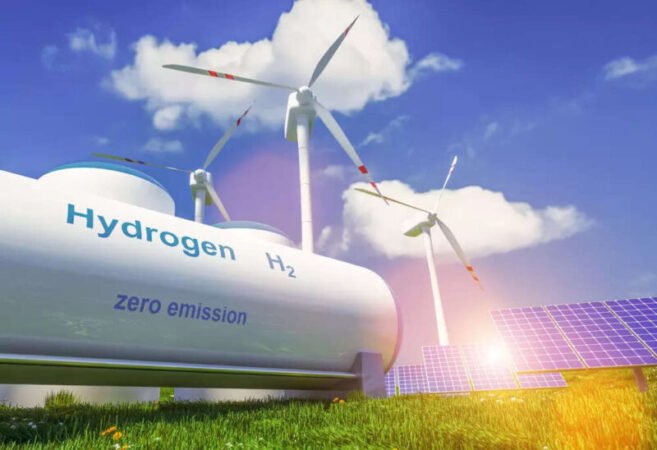India’s $2.3 billion plan can change its Green Hydrogen Industry

Indian Government has approved a $2.3 billion (Rs. 19,744 crore) incentive plan in the direction to make India a global hub for the production, utilization and export of green hydrogen and its derivatives. Here’s everything you need to know about Green Hydrogen and India’s National Green Hydrogen Mission
What is Green Hydrogen?
Green hydrogen is hydrogen that is produced using renewable energy sources such as wind or solar power. It is called “green” because the production process does not produce greenhouse gases or other pollutants.
Instead of using fossil fuels, which emit carbon dioxide and other pollutants when they are burned, green hydrogen is produced through the electrolysis of water. This process splits water into hydrogen and oxygen, using electricity from renewable sources. The oxygen is released into the air, and the hydrogen can be used as a clean fuel for transportation, heating, and electricity generation.
Green hydrogen has the potential to play a major role in the transition to a cleaner, more sustainable energy system.
How cost-effective is Green hydrogen production?
The cost of producing green hydrogen varies depending on the specific technology and energy sources used. In general, green hydrogen production is currently more expensive than hydrogen produced from fossil fuels, but the cost is expected to decrease as the technology improves and becomes more widely adopted.
There are a number of factors that can affect the cost of green hydrogen production, including the efficiency of the electrolysis process, the availability and cost of renewable energy, and the scale of the hydrogen production facility. Some estimates suggest that the cost of producing green hydrogen could be competitive with hydrogen produced from fossil fuels within the next decade, particularly as the cost of renewable energy continues to fall.
It is also worth noting that the price of green hydrogen does not include the external costs of fossil fuel production, such as the environmental and health impacts of air pollution. When these costs are taken into account, green hydrogen may be more cost-effective in the long run.

What are the potential benefits of using Green Hydrogen as an energy source?
- It is a clean, renewable energy source: Green hydrogen is produced from renewable energy sources, so it does not produce greenhouse gas emissions or other air pollutants during the production process.
- It has a high energy density: Hydrogen has a high energy density, meaning that it can store a large amount of energy in a small volume. This makes it an ideal fuel for transportation applications, where it can be used to power fuel-cell vehicles.
- It is versatile: Hydrogen can be used in a variety of applications, including electricity generation, heating, and transportation. It can also be used as a chemical feedstock in the production of various chemicals and fuels.
- It has the potential to contribute to energy security: Hydrogen can be produced and used locally, which means that it has the potential to reduce reliance on imported energy sources and improve energy security.
- It can help reduce greenhouse gas emissions: Green hydrogen can be used as a substitute for fossil fuels in various applications, which can help reduce greenhouse gas emissions and mitigate climate change.
What is National Green Hydrogen Mission?
The National Green Hydrogen Mission is a program launched by the Government of India to accelerate developing and deploying green hydrogen technologies in India. Green hydrogen is produced from renewable energy sources such as solar and wind, rather than from fossil fuels like natural gas. It is seen as a key technology for helping India reduce its greenhouse gas emissions and transition to a more sustainable energy system.
The mission aims to establish India as a global leader in green hydrogen production and use, and to create a supportive ecosystem for the development of green hydrogen technologies. The program includes a variety of measures, including research and development, pilot projects, regulatory frameworks, and public-private partnerships.
The National Green Hydrogen Mission is expected to play a significant role in India’s efforts to achieve its climate and energy goals and to contribute to the country’s economic development and energy security.
What are the key steps taken by the Indian government?
- With the aim of increasing non-fossil energy capacity to 500 gigawatts by 2030, India has started to produce green hydrogen.
- Indian Government has approved the mission with an initial outlay of ₹19,744 crore ($2.3 billion), out of which the government has allocated ₹17,490 crore ($2.2 billion) for the Strategic Interventions for Green Hydrogen Transition Programme (SIGHT) programme, ₹1,466 crore ($177 million) for the upcoming pilot projects, ₹400 crore ($48 million) for R&D, and ₹388 crore ($46 million) towards other mission components.
- To assist the development of the green hydrogen ecosystem, an enabling policy framework will be created. Additionally, a strong framework for norms and regulations will be created.
- The mission will facilitate the Strategic Hydrogen Innovation Cooperation (SHIP), a public-private partnership framework for research and development. The objectives, deadlines, and magnitude of R&D initiatives shall be appropriate for creating globally competitive technology. Additionally, a coordinated skill-development programme will be implemented.


















